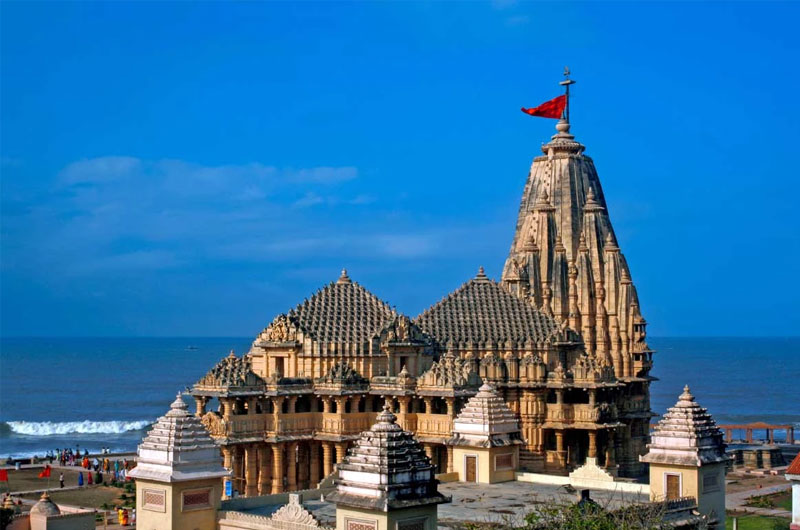
Somnath Temple: The Eternal Beacon of Gujarat’s Spiritual Heritage
The Somnath Temple, located in Prabhas Patan near Veraval in Saurashtra, Gujarat, stands as one of the most revered and ancient temples in India. Known for its divine significance and architectural splendor, Somnath Temple is a cornerstone of Hindu pilgrimage and history. This sacred site, dedicated to Lord Shiva, is famously celebrated for its recurrent reconstructions following multiple invasions and its prominent role in Indian cultural and spiritual life. With its breathtaking seaside location, rich history, and magnificent architecture, Somnath Temple offers a profound experience for devotees and travelers alike. This detailed guide explores the historical, architectural, and cultural dimensions of the Somnath Temple, along with practical travel information to enhance your visit.
Historical Significance
Ancient Origins
- Mythological Roots: The Somnath Temple is deeply intertwined with Hindu mythology. According to legend, the temple was originally constructed by the Moon God, Chandra, and later rebuilt by various dynasties over the centuries. It is considered one of the twelve Jyotirlingas, sacred shrines dedicated to Lord Shiva.
- Historical Relevance: The temple has witnessed several reconstructions due to invasions and destructions. Notably, it was rebuilt by the Chalukya King Bhimdev I in the 11th century, later destroyed by Mahmud of Ghazni in 1026 CE, and subsequently rebuilt by various rulers including the Solankis and the Mughal Empire.
Key Historical Events
- Mahmud of Ghazni’s Invasion: In 1026 CE, the temple was looted and destroyed by the Turkish invader Mahmud of Ghazni, leading to a period of decline. The temple’s resilience and the subsequent reconstructions highlight its enduring significance.
- Reconstruction by Sardar Patel: After India gained independence, the temple was reconstructed with contributions from various leaders, including Sardar Vallabhbhai Patel. The modern temple stands as a symbol of India’s cultural resurgence and unity.
Architectural Marvel
Temple Structure
- Main Shrine: The Somnath Temple’s central shrine is a grand structure featuring intricate carvings and sculptures. It is designed in the traditional Chalukyan architectural style, characterized by its grandeur and intricate artwork.
- Shikhara (Spire): The temple’s Shikhara, or spire, rises to a height of approximately 15 meters (50 feet) and is adorned with ornate carvings. The Shikhara symbolizes Mount Meru, the axis of the universe in Hindu cosmology.
Notable Features
- Raja Gopuram: The temple’s entrance, known as the Raja Gopuram, is an imposing gateway with detailed carvings depicting scenes from Hindu mythology. It serves as a grand welcome to the temple complex.
- The Mandapa (Pillared Hall): The Mandapa is a spacious hall with intricately carved pillars, showcasing various deities and mythological figures. It is used for religious ceremonies and gatherings.
- Ocean View: The temple’s location near the Arabian Sea enhances its beauty and provides a serene and picturesque backdrop. The waves of the sea are believed to offer divine blessings to the visitors.
Tourism Specialty and Locality
Unique Attractions
- Religious Significance: The Somnath Temple is one of the twelve Jyotirlingas, making it a crucial pilgrimage site for Hindus. The temple’s association with Lord Shiva and its historical resilience attract devotees from all over India and the world.
- Architectural Excellence: The temple’s architecture, with its intricate carvings, grand spire, and seaside location, offers a unique combination of spiritual ambiance and aesthetic appeal. It is an excellent example of traditional Indian temple architecture.
Locality
- Location: The Somnath Temple is situated in Prabhas Patan, a town in the Saurashtra region of Gujarat, approximately 80 kilometers from Junagadh and about 400 kilometers from Ahmedabad.
- Accessibility: The temple is well-connected by road and rail. The nearest major city is Veraval, which is accessible by train and bus. The nearest airport is in Diu, approximately 90 kilometers away, with regular flights connecting it to major Indian cities.
Best Time to Visit
Ideal Seasons
- Winter Season (October to March): The best time to visit Somnath Temple is during the winter months when the weather is pleasant and suitable for exploration. Daytime temperatures range from 15°C to 30°C (59°F to 86°F), making it comfortable for sightseeing and temple visits.
- Monsoon Season (June to September): The monsoon season brings heavy rainfall, which can lead to travel disruptions and less favorable conditions for visiting. However, the lush greenery and rejuvenated surroundings can offer a different experience.
Summer Season (April to June)
- Weather Conditions: The summer months can be extremely hot, with temperatures soaring above 40°C (104°F). While the temple remains open, the heat may make travel and outdoor activities less enjoyable.
Nearby Tourist Spots
In Gujarat
- Junagadh: Located about 80 kilometers from Somnath, Junagadh is home to historical sites such as the Uparkot Fort, Mahabat Maqbara, and Gir National Park. Junagadh offers a rich blend of history and natural beauty.
- Gir National Park: Approximately 100 kilometers from Somnath, Gir National Park is renowned for its Asiatic lions and diverse wildlife. It is a major wildlife sanctuary and a popular destination for nature enthusiasts.
- Diu: About 90 kilometers from Somnath, Diu is a coastal town with beautiful beaches, historic forts, and Portuguese architecture. It is a great place to relax and explore after visiting the temple.
Nearby Attractions
- Sasan Gir: Known for its wildlife sanctuary, Sasan Gir offers a chance to see Asiatic lions in their natural habitat. It is a popular destination for wildlife safaris and nature tours.
- Gopi Talav: Located near the temple, Gopi Talav is a picturesque water body with historical significance. It is a peaceful spot for reflection and relaxation.
Best Places to Eat
Local Dining Options
- Somnath Sagar Restaurant: Located in Somnath, this restaurant offers a variety of vegetarian dishes, including local Gujarati cuisine. It provides a comfortable dining experience for visitors exploring the temple.
- Hotel Sukh Sagar: Situated near the temple, Hotel Sukh Sagar serves a range of Indian and Gujarati dishes. It is a popular spot for travelers looking for a hearty meal.
Nearby Restaurants
- Khaman House, Junagadh: Located in Junagadh, Khaman House is known for its traditional Gujarati snacks and meals. It is a good option for travelers passing through Junagadh.
- Ankur Restaurant, Veraval: Situated in Veraval, Ankur Restaurant offers a range of Indian and regional dishes. It is a convenient dining option for those traveling to or from Somnath.
Hotels Near Somnath Temple
Luxury Hotels
- The Fern Sattva Resort: Located in Somnath, The Fern Sattva Resort offers upscale accommodations with modern amenities and a tranquil environment. It provides a comfortable and luxurious stay for visitors.
- Hotel Somnath Palace: A premium hotel in Somnath, Hotel Somnath Palace features elegant rooms, fine dining, and excellent service. It is well-suited for travelers seeking a high-end experience.
Budget Hotels
- Hotel Shree Ram: Situated in Somnath, Hotel Shree Ram offers affordable lodging with basic amenities. It is a practical choice for budget-conscious travelers and pilgrims.
- Hotel Prabhat: Located near the temple, Hotel Prabhat provides economical accommodations with essential facilities. It is a convenient option for visitors looking for budget-friendly options.
Pilgrimage and Visitor Experience
Preparing for the Visit
- Travel Preparation: Visitors should plan their trip in advance, considering travel logistics, accommodation, and local transportation. It is advisable to carry essentials such as water, sunscreen, and comfortable footwear.
- Entry and Tickets: There is no entry fee to visit the Somnath Temple. However, donations and offerings are welcomed. Visitors should respect the temple’s customs and dress modestly while inside the temple premises.
Exploring the Site
- Guided Tours: Guided tours are available and can provide valuable insights into the temple’s history, architecture, and religious significance. Tours can be arranged through local tour operators or the temple administration.
- Souvenirs and Shopping: The area around the temple features small shops selling religious artifacts, souvenirs, and local products. Visitors can purchase mementos to remember their visit and support local artisans.
Conclusion
Somnath Temple, with its profound historical significance, architectural grandeur, and spiritual aura, remains a beacon of Gujarat’s rich cultural heritage. Its divine connections, resilient history, and breathtaking seaside location make it a unique destination for spiritual seekers and travelers. Whether you are visiting for pilgrimage, historical exploration, or architectural admiration, Somnath Temple offers a deeply enriching experience amidst the timeless beauty of Gujarat.
